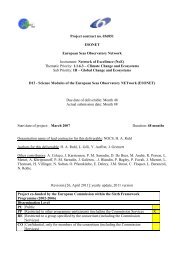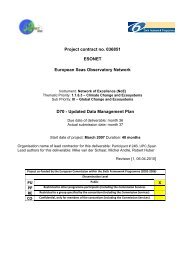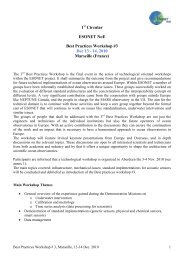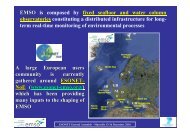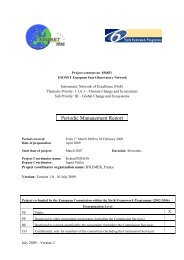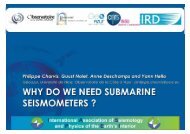Project Deliverable D50 Report on Best Practices ... - ESONET NoE
Project Deliverable D50 Report on Best Practices ... - ESONET NoE
Project Deliverable D50 Report on Best Practices ... - ESONET NoE
Create successful ePaper yourself
Turn your PDF publications into a flip-book with our unique Google optimized e-Paper software.
Ecological communities<br />
Author: H. Ruhl (NOCS)<br />
Slides in Annex F4<br />
Abstract: (extracted from Gillooly et al. 2010) Marine life is widely regarded for its diverse<br />
array of form, splendour, and renewable food resources, but marine organisms also have<br />
critical biogeochemical and ecosystem functi<strong>on</strong>s. Marine ecosystem functi<strong>on</strong> maintains key<br />
services like primary producti<strong>on</strong>, climate regulati<strong>on</strong>, carb<strong>on</strong> sequestrati<strong>on</strong> and storage, and<br />
living resources like fisheries and natural molecular products. Specimens collected from<br />
marine habitats during observatory operati<strong>on</strong> in deep-sea and extreme envir<strong>on</strong>ments could<br />
have potential for cancer, antibacterial, extreme envir<strong>on</strong>ment enzymes, and other beneficial<br />
molecular products.<br />
The oceans are filled with natural and biological sounds, although many artificial sources<br />
have c<strong>on</strong>tributed increasingly to its overall noise budget. How these anthropogenic sources<br />
are affecting marine life c<strong>on</strong>stitutes an issue of c<strong>on</strong>siderable interest both to the scientific and<br />
public community. The design and implementati<strong>on</strong> of research <strong>on</strong> the effects and c<strong>on</strong>trol of<br />
man-made noise in the marine envir<strong>on</strong>ment will be interdisciplinary and will use informati<strong>on</strong><br />
provided by existing and future underwater observatories.<br />
The pace and scale of anthropogenic changes occurring in the oceans and the impact of these<br />
changes <strong>on</strong> marine biodiversity and ecosystems are cause for serious c<strong>on</strong>cern. Ocean<br />
observatory research efforts to better understand marine biodiversity will provide the<br />
knowledge necessary to inform an adaptive management process by linking variati<strong>on</strong>s in<br />
biodiversity, its functi<strong>on</strong>, and the ecological and envir<strong>on</strong>mental forcing that drive change in a<br />
comprehensive way.<br />
The persistent discovery of life in envir<strong>on</strong>ments that were previously thought to be relatively<br />
devoid of life c<strong>on</strong>tinues to redefine the fundamental abundance, distributi<strong>on</strong>, and functi<strong>on</strong> of<br />
life <strong>on</strong> earth. The discovery of microbial life in hypersaline brine in sediments several<br />
hundred meters below the seafloor and chemosynthesis-based communities at the seafloor<br />
c<strong>on</strong>tinue to redefine understanding of life and ecosystem tolerances. While chemosynthetic<br />
systems are spatially isolated compared to photosynthetically-driven systems, they provide<br />
excellent opportunities to study systems which are partly independent from solar energy.<br />
Quantifying the diversity of form and metabolic functi<strong>on</strong> in these extraordinary communities<br />
c<strong>on</strong>tinues to be a major research focus with direct links to geoscience (see also <str<strong>on</strong>g>Deliverable</str<strong>on</strong>g>s<br />
11 and 46 of <strong>ESONET</strong> <strong>NoE</strong>).<br />
References :<br />
K. L. Smith, H. A. Ruhl, B. J. Bett, D. S. M. Billett, R. S. Lampitt, and R. S. Kaufmann,<br />
2009, Climate, carb<strong>on</strong> cycling, and deep-ocean ecosystems, Proceedings of the Nati<strong>on</strong>al<br />
Academy of Sciences of the United States of America, vol. 106, no. 46, pp19211–19218.<br />
Ruhl HA, et al. Societal need for improved understanding of climate change, anthropogenic<br />
impacts, and geo-hazard warning drive development of ocean observatories in European Seas,<br />
Progress in Oceanography (submitted), (<str<strong>on</strong>g>Deliverable</str<strong>on</strong>g> 11 (EU Sixth Framework <str<strong>on</strong>g>Project</str<strong>on</strong>g><br />
<strong>ESONET</strong> <strong>NoE</strong> c<strong>on</strong>tract no. 036851. 2010).<br />
Gillooly, M, et al., <str<strong>on</strong>g>Report</str<strong>on</strong>g> to EMSO <strong>on</strong> Implementati<strong>on</strong> Model. <str<strong>on</strong>g>Deliverable</str<strong>on</strong>g> 46 (EU Sixth<br />
Framework <str<strong>on</strong>g>Project</str<strong>on</strong>g> <strong>ESONET</strong> <strong>NoE</strong> c<strong>on</strong>tract no. 036851. 2010).<br />
<str<strong>on</strong>g>Deliverable</str<strong>on</strong>g> #50 - update October 2010 23



